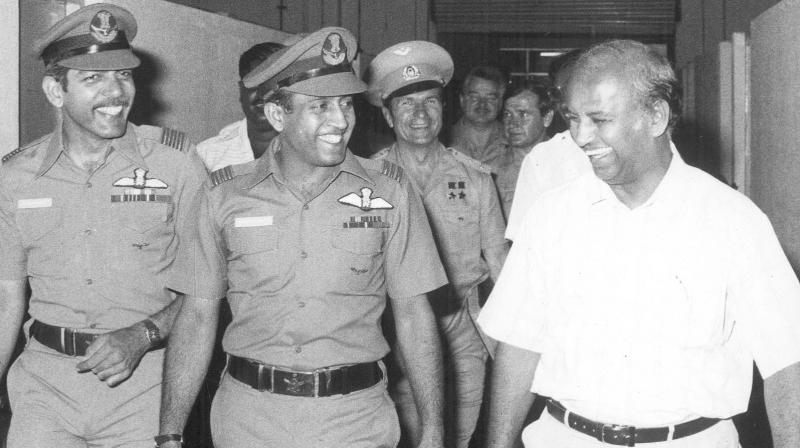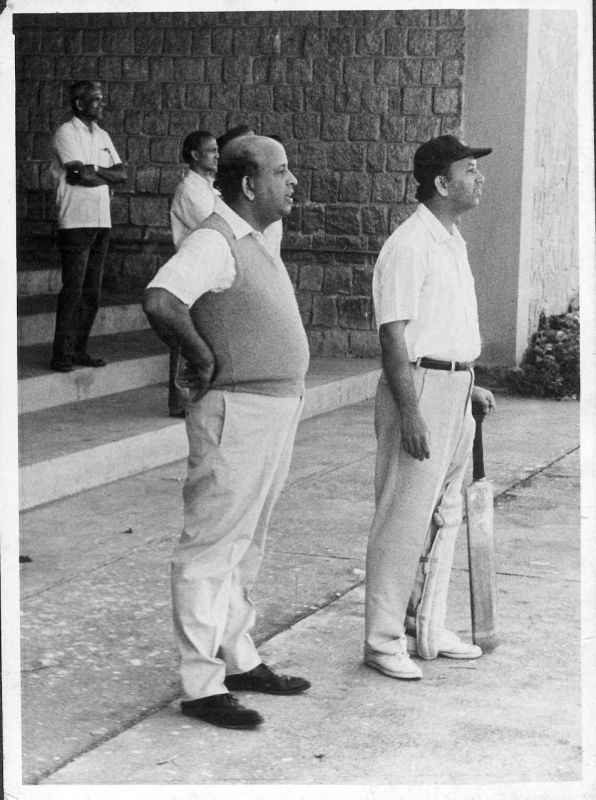Stars in his eyes, galaxies in his sights

Professor U.R. Rao’s visionary attribute is mirrored by the fact that he addressed futuristic concepts like the colonisation of Mars, after meeting societal needs of a developing nation like India. His co-author on the subject of colonisation was none other than the celebrated science fiction writer Sir Arthur C. Clarke. That apart, he also advocated a manned mission, reasoning that 50 years from now, other countries will start exploring the Moon and Mars for resources. Will his colleagues live up to his vision? B.R. Srikanth pays tribute.
An inspirational personality with an excellent degree of professionalism, Prof U R Rao put behind a couple of failures in the nascent years of Indian space programme to encourage his colleagues to raise the bar rather than rest on past laurels. He put behind a couple of setbacks to health as well, a paralytic stroke, issues with heart, even a bought o jaundice a couple of months ago, to head to Antriksh Bhawan even on holidays-either to chair meetings or read up scientific papers. He retired as Chairman of ISRO 23 years ago, but made it a point to be the first to arrive in office, and leave late in the evening. He would be on hand for a quick word on advise on any problems plaguing satellite and rocket scientists alike and make it a point to travel to Satish Dhawan Space Centre (SDSC), Sriharikota Range for witness all flights of PSLV and GSLV, and praise his colleagues for successful mission.

Prof Rao, however, made no bones when recognition of his contribution to the space programme came a tad late with the Union government bestowing Padma Vibhushan award in January 2017. He remarked sarcastically that he expected the government to announce the award posthumously! As one of India’s most celebrated scientists, he could not cloak his disappointing over the delay in the government according him due recognition.
His pioneering work in satellite technology without doubt eclipses his significant contribution to development of rocketry. He accelerated the development of ASLV though the programmed endured a couple of failures. “Prof Rao asked me to chair an external committee to probe these failures with experts from various institutes. It took us a year to figure out the problem. Once the modifications were made to overcome the failures, the subsequent flights were successful,” says Prof Roddam Narasimha adding “he just did not stop working (post retirement in 1994). He could not because of the things had wanted to do for the country.”
Prof Rao’s successor Dr K Kasturirangan, who described Prof Rao as the father of India’s satellite programme, spoke of the awe-inspiring effort of the legendary scientist to built ISRO’s Satellite Centre (ISAC) from within the confines of a shed in Peenya Industrial Area to a state-of-the-art facility with 2500 engineers and scientists who have fabricated a variety of satellites as well as probes to Moon and Mars.

“He was very dynamic and extraordinary visionary,” he said. It’s such dynamism and vision which helped the country’s space agency join an exclusive league with successful outings to Moon and Mars.
When Prof escaped kidnap attempt
One morning in 1992, Prof Rao, who was Chairman, ISRO, was stunned into silence when he got a call from Commissioner of Police R Ramalingam. For, the top cop explained to Prof Rao how he escaped a kidnap attempt, perhaps by providence or an intervention from outer space, by G Narayana Gowda, president of Kannada Rakshana Vedike and his supporters. He had arrived at his office oblivious of the drama outside his residence in upscale Indiranagar an hour earlier. Mr Ramalingam told Prof Rao how Mr Narayana Gowda and his supporters had tailed him for almost a month and even followed him to a facility of the space agency near Tirupati and back to Bengaluru as they wanted to whisk Prof Rao away, hold him to ransom and gain international prominence for kidnapping Chairman of ISRO.
The conspiracy came a cropper as an informant among the group tipped off Mr Ramalingam the previous night, prompting him to post police officers dressed as men heading for a wedding, near Prof Rao’s residence. When Prof Rao’s Ambassador car did not arrive at 8-30 AM, Mr Narayana Gowda and his men decided to barge into Prof Rao’s residence, armed with crowbars and machetes. They were, however, nabbed by the posse of police officers at the gate and dragged away to the local police station where they spilled the beans about their plan to hold him hostage. He was advised to appoint an armed personal security officer and to not travel without adequate security. “I don’t know what happens en route to office or home because I either read files or a newspaper,” was Prof Rao’s reaction when asked about the abduction attempt.
AS Kiran Kumar, Chairman, ISRO
His (Prof Rao) contribution to space science and technology in our country is phenomenal. One can see his imprint on all types of satellites-whether they are communication and meteorology or remote sensing satellites. He came across as a person who wanted things to happen quickly and did not mind doing them all by himself as we once watched him pick up a soldering rod to fix a snag which was noticed during testing of Bhaskara satellite before its launch by a Soviet rocket. His intellectual capability was phenomenal as he demonstrated his expertise in diverse areas.
Dr R Aravamudan, former director, ISRO Satellite Centre
He was a full-time scientist. He retired in 1994, but he would not sit at home. In fact, we had reserved a room for him in the headquarters. He would be there before anyone else. He would walk in at 8.30 every morning and read up scientific papers, research. He would go home only by 5 PM. His mind was always on Science.
 Prof Rao with late Prof Satish Dhawan
Prof Rao with late Prof Satish Dhawan
Dr K Kasturirangan, former chairman ISRO
I owe much to him (Prof Rao) for the present status I enjoy in the country. I should say I was most privileged to work with him and my own career got a real boost. Prof. Rao played a pioneering role in developing India's satellite capability. He had to develop human resources right from a scratch and technologies that ISRO was not familiar with during the times when industrial base was also poor. Against all these odds, he led a team, built Aryabhata satellite in 36 months, a record. Then onwards, he headed space activities in ISRO, whether it's 'Bhaskara' (satellite) or IRS (Indian Remote Sensing)...things of that kind. All these were products of his vision to build satellite capability of the country on a scale which is what is being felt today.
Prof Roddam Narasimha, former Member, Space Commission
He was a pioneer in satellite programme though he initially worked out sheds in Peenya Industrial Area but his involvement in satellites continued till the end. Last week, he was scheduled to chair a meeting but he could not come because of poor health. He was a scientist at heart and promoted projects which involved scientific studies. He came from a generation which felt that India should lead the rest of the world in space technology.
Prime Minister Narendra Modi
Saddened by demise of renowned scientist, Professor UR Rao. His remarkable contribution to India’s space programme will never be forgotten.
'Colonisation of Mars will take us 500 years'
Prof Rao’s first priority was to provide bread and butter or solve societal issues and make available basic facilities : provide facilities like communications to connect remote areas, state-of-the-art met forecasts, distance education, and management of natural resources through space technology. With a constellation of INSAT multi-purpose satellites and IRS (remote sensing) satellites in place, Prof Rao egged his colleagues to embark on ambitious projects like exploration of other planets and an Indian’s outing into space onboard an indigenous rocket. His argument: The question of how soon a manned flight could blast off from the spaceport at Sriharikota or when an Indian could head to Mars would be difficult to estimate, but ISRO should develop the know-how as human colonies on Moon and Mars could be a reality by 2030. “There is no choice but to embark on a manned mission because 50 years from now other countries will start exploring them Moon and Mars for resources, and we cannot sit here and buy those resources from others. There are no short-cuts. We must have a very clear idea about how we must proceed as a nation though some people will raise questions about the cost of such missions. Of course, we must prove the reliability of GSLV as otherwise a single mishap in space will set off an outcry about the programme,” he told this correspondent during a recent interview.
He also believed that Mars was the best planet to be colonised in the next 100 or 500 years. “The late Sir Arthur Clarke and I presented a paper a couple of years before his death on colonisation of Mars. My great friend felt this could happen in the next 100 years, but I think it may take 500 years. Landing will happen quickly, but colonisation means we must build an atmosphere just like we have over the Earth, and build a greenhouse to reduce the difference between day and night temperatures. I think colonisation is necessary as we are running out of resources like oil and iron ore and must look for them on the Moon and Mars. Of course, we must bring down the cost of space transportation,” was how he summed up the need to develop new colonies, and explore them for resources.
And with ISRO reaching Mars in the first attempt, he set the bar higher for his colleagues, suggesting an outing to Venus, and a second visit to Mars a couple of years later, all to unravel mysteries about birth and evolution of the world. “Our papers (based on data from these missions) must be world-class. Otherwise, there’s no point in spending on these missions,’ was the explanation about him being fastidious in selection of instruments for each of these outings.

